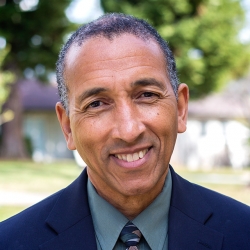
Edwin Nebblett, MD
A Message of Hope#

Jesus had just performed His first two miracles, turning the water into wine at the wedding in Cana and healing the nobleman’s son in Capernaum. Then it records in John 5:1-18 that Jesus journeyed to Jerusalem. Jesus is again in Jerusalem and as He is in apparent meditation and prayer He comes along the Pool of Bethesda and sees a certain man lying there; and it is the Sabbath day.
Being involved in primary care as I am, I notice John does something that Luke would do: he mentions timeframes. He makes it very clear that the individual that we are about to encounter had been ill for 38 years. There are a couple of background items that we need to be aware of. First of all it being the Sabbath day, Jesus knew that healing someone on the Sabbath this early in His ministry would so excite the Jews that they would cut short His work. Not that it was a wrong thing to do; but there are times when you have to use your judgment and you have to say that this may be lawful, but it is not expedient.
But Jesus sees this one case of supreme wretchedness: a man who had been a cripple for 38 years, and in a great degree as a result of his own sin. He approaches him. The significant thing that occurs here for me is He asks a question: Do you want to get better?
Now I’m thinking to myself: You’ve been sick for 38 years, you’re suffering and you want to get better. Somebody comes to you and says, “Do you want to get better?” What’s your reaction? It’s kind of like,Really? Sarcasm. Really? Ok, I’m lying here, a real wreck, and you’re asking me that question?
But that is not the way the record goes. This sick man brings forth the reality, the other background factor. He says, “I can’t get better; here’s my circumstance.” And this is the first challenge that we’re oftentimes faced with when we’re saying there is another reality that’s available, a healing. How often do we deal with individuals, asking them, “Do you want to get better?” and they say, “You don’t understand—here’s my circumstance”?
So this man gives the reality: “I can’t get to the pool.” With that background we see five points. First: We don’t know much about this recipient; all we know is that he is disabled. Second: He had been an invalid for 38 years. Third: He was alone. Fourth: He had never heard of Jesus. In verse 13 when they asked who healed him, he said, “I have no idea.” So he did not know Jesus; it was the beginning of Jesus’ ministry and the word had not gotten out.
But the fifth point I want to bring out is that in spite of him not knowing Jesus, there was something he saw in Jesus and he was obedient. And here’s where the challenge comes in for us when we are confronted with the question, Do you want—? The question really is, Are we willing to be obedient?
With this backdrop, what lessons can we learn? Being disabled, the sick man had probably tried everything that he could do. He probably had family there to help him from time to time. But at this point there was no one was there to help him. He was left alone.
Our compassion index for our patients is really heightened when we ourselves have gone through a similar experience and we understand how lonely pain and suffering can be. Because as well-meaning as our families or loved ones can be, “nobody knows the trouble I’ve seen.” Nobody knows but…Jesus. Suffering is intensely personal. The man wanted to be well, but he needed somebody’s help. He sincerely thought that if he could get there when the water was troubled, he would be healed. The problem was he could not.
Not knowing who Jesus was, and not having the ability to go to Jesus, Jesus came to him. Now that is a picture of Jesus that I really like in this story. Oftentimes we are just incapable. Either mentally, spiritually, physically; we cannot go to healing. But that does not mean that healing cannot come to us. That’s a picture of Jesus that I really like. And so Jesus asks the question, “Wilt thou be made whole?”
The first lesson we can learn is this: Help sometimes comes from unexpected sources. Patients I deal with who pray for healing and want healing, want healing in a way that they understand. That’s something we all want. When I have a toothache, I want healing in a way that I understand. I go thereand get that kind of help and I receive healing from my suffering. But sometimes the answer comes in a way that’s unexpected.
Here’s the second lesson. When Jesus said to him, “Take up your bed and walk,” the man obeyed. Sister White talks about the fact that in acting out on the statement, “Get up”—in that action, he was healed. Sometimes we have to recognize that we have a part to play in our own healing.
At New Year’s people often resolve that they’re going to do something different because they want a different outcome. Oftentimes that resolution only lasts for a very short period of time. But one thing is for certain. To act our part, we can’t follow the definition of insanity, which is to continue doing the same thing we’ve been doing and expecting different results. The reality is it has to be a permanent lifestyle change.
That is one of the things that I now challenge my patients with. You want to lose weight? You want me to prescribe Penteramine. That is not the answer. And I speak very briefly about the yo-yo phenomenon. But then I give them the bottom line: If you want weight loss, you can have it; but you must permanently do something differently than what you’re doing now. And that is a price that many patients are not willing to pay, to be very straightforward.
“Jesus does not ask this sufferer to exercise faith in Him. He simply says, ‘Rise, take up thy bed, and walk.’ But the man’s faith takes hold upon that word….Without question he sets his will to obey the command of Christ, and all his muscles respond to his will. Springing to his feet, he finds himself an active man.” Desire of Ages, 202-203.
The last lesson is: Jesus gave him no assurance of divine help. He didn’t even know who Jesus was. He might have stopped to doubt and lost his one chance of healing. We don’t have any recorded story that Jesus ever went back to that pool. But he believed, and in acting, he received strength. In other words, just do it. Do it because it needs to be done. Then go about doing what it takes to answer the prayer that you have prayed.
What I take away from this particular story is that we have an opportunity to respond as the paralytic did. And in so doing, we can receive the healing that we want. We have a part to play. We have to encourage our patients with that truth: You want a different outcome? You need to do something different than what you’re doing now.
Finally, 38 years is a long time to be sick. I deal with a chronicity of care, and it tends to be discouraging after 38 years; nothing is going to be different. But that is not true. As I tell my patients, “We have two choices here: I can medicate you to health, which is an oxymoron. Or you can take the initiative to move toward health. And I’m here to help you. Get rid of me. I enjoy taking care of you, but you have things to do, places to go, people to see, and I am not the final solution. But you are, and I can show you the way, if you’re willing.”
So I encourage my patients, and myself as well, that while 38 years may seem like a long time—and it is—it is by no means a hopeless, helpless situation. You can be healed. That is why I call this story of the Pool of Bethesda, A Message of Hope.
